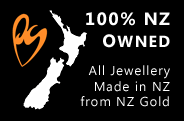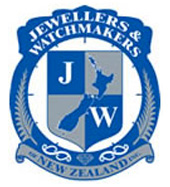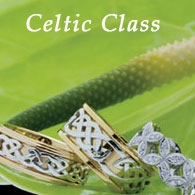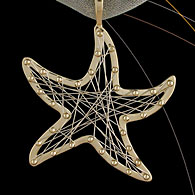METAL PROPERTIES
When choosing a ring it is important to consider the metal used to make the ring and whether the metal properties are suited to your lifestyle. This becomes even more important when the ring in question is your wedding ring. You will be selecting a ring which you will be wearing every day for the rest of you life. Not only should you love your ring and be happy to have it adorn your hand for the years to come, but it should also keep its lovely looks as each anniversary passes.
We have rings available to be made in numerous metal options. It is important to then understand what those options ultimately mean in terms of the final appearance of the ring, and how it will behave in the years ahead.
The following information can also be useful when considering other jewellery options. However, the issue of durability is more important with rings than any jewellery type due to the amount of wear and tear they face simply by being on our hands.
This package has been put together with a focus predominantly on wedding ring selection. However, notes are included throughout that indicate information relevant to other jewellery types. Also in this package is information that relates to several metals that we don�t sell. Even if you choose to shop elsewhere for your jewellery, we would like you to be informed on what you are purchasing.
Can Gold Rings Bend Out of Shape?
If your ring is getting thin or made from a soft metal like 9ct white gold it may get bent out of shape. We can easily reshape your ring using our jewellers' tools, but unless it's quite badly out of shape, you could opt to keep wearing it out of shape as your finger will just merge into that shape the ring has taken. If your worried, e-mail Peter Shakes at peter@petershakes.com with a picture of your ring and we will let you know what to do
Does White Gold Rub Off?
All gold will eventually abraid away in time ... depending on how hard the ring is worn. This happens much quicker on soft metals like silver and 9ct white gold, whereas Platinum will last much longer because the metal is so dense. However, what you most likely are seeing is the rhodium coating wearing off and exposing the true colour of gold underneath.
If it's been made in Asia and bought from a chain store, it is likely quite yellow underneath. We can re-coat your ring back to new. Click here to make and appointment to have a free consultation.
Can Dents Be Taken Out of 18ct gold Rings, 9ct Gold Rings, 14ct Gold Rings, Platinum Rings?
Yes with our hi tech laser welder we can restore your ring back to new Click here to make and appointment to have a free consultation
HARDNESS AND MALLEABILITY
Many people are aware that various metals are stronger than others. However, the term "stronger" can actually be slightly misleading. There are several factors to consider when choosing a metal for your ring.
When jewelers discuss the strength of a metal they are generally referring to the ability of the metal to withstand dents and scratches. The strength of a metal in this instance is measured on the "Vickers" scale. The rating of a metal on the Vickers scale will actually change during different points in a rings construction. Final pieces will also vary depending on how the piece was created and how the jeweller who crafted the piece handled it.
A rating on the Vickers scale is calculated by applying a diamond point to a metal surface under pressure and calculating the level of indentation left. To give you a brief summary of the way several metals rate on the Vickers scale, here is a quick list of average ratings for different metal type for you to compare:
- Sterling Silver = 90
- 9ct gold = 120
- 14ct gold = 125
- 18ct gold = 130
- Palladium = 160
- Platinum = 165
- Titanium = 300
Hardness is different from the malleability of a metal. The strength of a ring in maintaining its round shape is affected by metal choice to a certain extent. More important in this case is the solidity of the ring's construction. If you have chosen a ring design that has a very fine or narrow band, then malleability can be a more important consideration as the band may become bent out of shape.
GOLD
Most people are aware that gold is available in various carats. To many customers these differences imply a change in price, but they are unsure how it further relates to the properties of the metal they are buying.
Gold alloys for jewellery are made up of a percentage of pure gold and the remainder is made up of combinations of copper, silver, palladium and/or other metals. The carat rating of an alloy refers to the percentage of gold in the alloy. Those percentages are:
- 9ct = 37.5% gold and 62.5% other metals
- 10ct = 41.7% gold and 58.3% other metals
- 14ct = 58.3% gold and 41.7% other metals
- 18ct = 75% gold and 25% other metals
For most practical applications, 9ct and 10ct gold are almost identical in their properties and are simply the standards adhered to in different places. 9ct golds are most commonly found in the UK and European markets, while 10ct is the minimum gold classification on the American markets. Many jewelers are slowly converting to the US scale due to the massive buying power of the American consumer base. From here when we discuss the qualities on 9ct gold it will also refer to the properties of the 10ct golds.
To discuss the differences in greater detail we will break up the gold options into their different colours.
YELLOW GOLD
This is the traditional "Gold" colour that most people envisage when considering gold jewellery. Most yellow gold items have copper and silver added to gold in the various ratios listed above. The copper provides additional strength to the mix, while the silver counteracts the pink tinge of the copper.
Most people have been told that 9ct is the strongest of the golds. This is only true in terms of its malleability, making it ideal for gold chains. The 9ct yellow golds are generally ranked lower on the Vickers scale than an 18ct yellow gold would be. This is due largely to the amount of silver in the alloy, which is softer than gold and means that a 9ct gold is more likely to show dents than an 18ct will. If you are considering a ring of very fine and narrow construction then a 9ct may offer more structural durability - however the difference is minimal. A 14ct gold is often a good choice in yellow gold as is sits halfway between the 9ct soundness and the 18ct toughness.
Another major difference in the carats for yellow gold is in the colour tone of the metal. An 18ct gold will have a vibrant yellow tone, which has the rich glow we generally associate with gold. By comparison a 9ct yellow gold is a far more muted and faded yellow tone. This is the result of the additional metals in the alloy diluting the genuine gold's shine. A 14ct gold has a far brighter tone than the 9ct, but not quite the vibrant depth of the 18ct. All of our rings are available in 9ct, 10ct, 14ct and 18ct yellow gold.
WHITE GOLD
As the name suggests, white gold is a metal alloy that is crafted to have a "white" tone. In order to achieve the white colouring, the metal alloy is given very little copper and significantly higher portions of silver, palladium, nickel or other white metals (although nickel is very rarely used now). This gold mixed alloy is actually a grayish tone in its natural state. Jewellery sold as white gold is then almost always given a rhodium plating to give it the "white" colour we see in store windows
This layer of rhodium plating, like any plated metals, will rub off over time. In order to keep white gold looking pure white, the ring will need to be re-plated every 12-24 months depending on the individual and their lifestyle.
Because of the treatment of white gold with rhodium plating, the effects of the various carats are somewhat lessened then discussed for yellow gold. The rhodium plating offers a certain amount of protection for the white gold underneath. Rhodium is quite a strong metal and it will absorb some minor impacts from affecting the white gold structure underneath.
Some people will find they do prefer the slightly grayish tinged richness of the white gold, in which case rhodium plating will not be necessary. Additionally, in many cases of two-toned rings, the white gold will not be plated but left in its natural state. This is where the differences in the various gold carats will need to be considered. In contrast to the yellow golds scale of strength, in white gold the strongest metal, both in terms of hardness and malleability, is the 14ct. Due to presence of additional silver in the alloy of a 9ct and the additional gold in the 18ct, the 14ct is the blend that hold the best balance of metals ratios for strength. For this reason 14ct is often recommended as the best white gold option for men.
Finally, in terms of appearance, the carat weighting of white gold is less visibly noticeable than in the yellow gold. The difference is predominantly seen in the vibrancy or shine of the metal. When viewed side by side, a 9ct white gold will appear dullish while the 18ct will have a deeper shine and warmth.
All of our rings are available in 9ct, 10ct, 14ct and 18ct white gold.
ROSE GOLD
Where weighting the alloy ratio towards silver makes white gold, weighting the metal ratio towards copper makes rose gold. Rose gold has a distinctive pinkish tinge that can result in a lovely warm tone and is particularly suited to designs that have an antique style or to people with fair skin tones.
Due to the additional copper in the alloy, rose gold is the strongest of the gold options. However, while the additional copper strengthens the ring, it also results in a greater difference in appearance for the various carats.
While an 18ct rose gold is a subtle rose tone that shines with rosy warmth, the 9ct rose gold can be heavy, dark and dull. Due to the comparatively small ratio of gold to copper in the 9ct, the luster of gold can be all but swamped by the coppers tones. The 18ct holds the qualities of the natural gold and allows the copper to highlight and tint the final tone. Once again, the 14ct sits comfortably between the higher and lower options.
All of our rings are available in 9ct, 10ct, 14ct and 18ct rose gold.
FINAL NOTES ON GOLD
For women, it's important to match the carat strength of your engagement ring to your wedding ring, particularly if you are planning to wear them on the same finger. By matching the gold carats, not only are you likely to get the best colour match, but the rings will also be the same strength. If you have two rings and one is stronger than the other, the stronger ring will slowly damage the weaker one over the years.
This applies to other metals also. If you have a platinum engagement ring, you ideally should select platinum as the material for your wedding ring or you risk the platinum damaging a weaker metal. Also keep in mind that gold is quite a versatile metal and can be combined with other metals, not just other golds.
STERLING SILVER
Sterling silver is an alloy comprising of 92.5% silver and 7.5% other alloyed metals. The finish of sterling silver is a "pure white" metal tone that achieves a high shine. The benefit of silver as a jewellery medium is primarily in its ease to work and relatively inexpensive price.
There is one primary downside to silver, particularly as a metal for rings. Silver is a comparatively soft metal, which is prone to both scratching and bending. While having a sturdy design can control the integrity of the rings structure, the nicks and scratches will show up over time no matter how well the ring is made. This makes silver far more suited to dress rings and fashion rings, but not ideal as wedding rings.
We do not normally manufacture our pieces in sterling silver, only in special circumstances.
PLATINUM
For most people this is considered the premiere choice for jewellery, especially wedding rings. As a metal, platinum is strong and sturdy with a pure white colour that will not require rhodium plating. The strength of the metal makes it particularly good for using in the setting of diamonds and other gemstones, as the metal will hold its structure more solidly than any other metal. However it will still be susceptible to denting over time.
The density of platinum gives a finished piece a feeling of solidity and quality which many people find pleasing. The metal itself shines with a high polish. In terms of the final alloy, platinum is used as a nearly pure metal. It is typically hallmarked with the number "950" indicating that the platinum is 95% pure.
The major down side to platinum is in its cost. At the time of writing this article, platinum prices for a finished ring are roughly double the cost of 18ct gold. This factor alone puts platinum beyond the consideration of many customers despite its many benefits.
All of our designs are available in platinum. Please contact us to request a quote.
PALLADIUM
This is a relatively new metal being used throughout the jewellery industry. Palladium is a metal that is refined from the same ore that produces platinum and rhodium. In terms of its use in jewellery, it is almost identical to platinum. Unfortunately, being relatively new to the jewellery industry, it is not as well known by customers and is therefore not used by all manufacturers yet.
Palladium is another exceptionally strong metal and is only 10 points lower than platinum on the Vickers scale. It is a pure "white" colour and will not require rhodium plating over the years to maintain the clear tone. Visually, palladium and platinum are almost indistinguishable from one another.
The one point that some customers may dislike about palladium is the weight of the finished piece. Palladium as a metal has a relatively low density. This does not affect the structural integrity of the ring, but it does make the finished piece feel lighter than the same piece in gold or platinum. For people who enjoy the heavy weighted feeling of jewellery, they may be a little disappointed with a palladium piece. On the other hand, this low density has a number of benefits, including its use for making larger, "chunky" pieces without them feeling too heavy when worn. This is particularly useful with large necklaces, earrings and rings.
The other benefit arising from the palladium's low density is in the cost. If you were to look at a per-ounce cost comparison of gold and palladium, there is relatively little difference. However, given the low density, palladium requires far less "weight" of metal to craft the rings "volume". What this ultimately means for customers is that a ring in palladium will generally have a final retail value somewhere between the price for that same ring in 9ct and 14ct gold.
TITANIUM
Titanium is another relatively new jewellery metal on the market. Like the Tungsten Carbide, Titanium is an extraordinarily strong metal. It is available in a large range of colours and is a very low density metal.
Points to be wary of with Titanium are identical to those listed for Tungsten. The titanium rings can't be resized and can barely be engraved. There is also a range of sub-quality Titanium variations on the market so be certain you are buying from a reputable dealer.
We do not sell any rings in Titanium.
JEWELLERY PRECIOUS METALS SUMMARY
Planning a wedding can be an expensive prospect and the rings will often represent somewhere between 10% and 20% of your total wedding budget. Given that the rings and the photos are the only items that will stay with you for the entirety of you marriage, this is not unreasonable. Once the dress is packed away, the meals forgotten and the stationary is in the recycling bin, the rings will stay with you always as a reminder of that wonderful day. However, it is also the worst time to spend more money than you need to get the ideal ring for your situation.
It is impossible to categorically state that any one metal is the best to be used for a wedding ring, as it will largely depend on the tastes and lifestyle of each individual customer. Your colour preferences, the amount of heavy work you do with your hands, your budget and the availability of your preferred design in the various metals will all impact which is the best selection for you. Gold will probably remain a sentimental favourite for weddings rings, but it is no longer the only choice.
Unfortunately, no matter which metal you use, no ring is going to look brand new forever. But the correct metal choice will make a big difference to the longevity of your ring. Combined with the occasional service by a jeweller, the right ring should be cherished for the many years ahead.
In this Section
News and Media
Bride and Groom Magazine - Feb - April 2009 Bride To Be - Feb-Apr 08 National Jewellery Showcase Award New Zealand Weddings - 2007Testimonials
Glynn
We had our wedding rings made by Peter Shakes and the entire process was stress-free and the outcome very pleasing. Peter and his team took time with us and were instrumental in assisting with our decision making on what rings to have made.
Their very helpful and knowledgeable advice ensured the rings were exactly what we wanted and made our wedding day all the more special.
More Testimonials

Proud to be members of Jewellers and Watchmakers New Zealand, abiding by their ethics and code of conduct.



